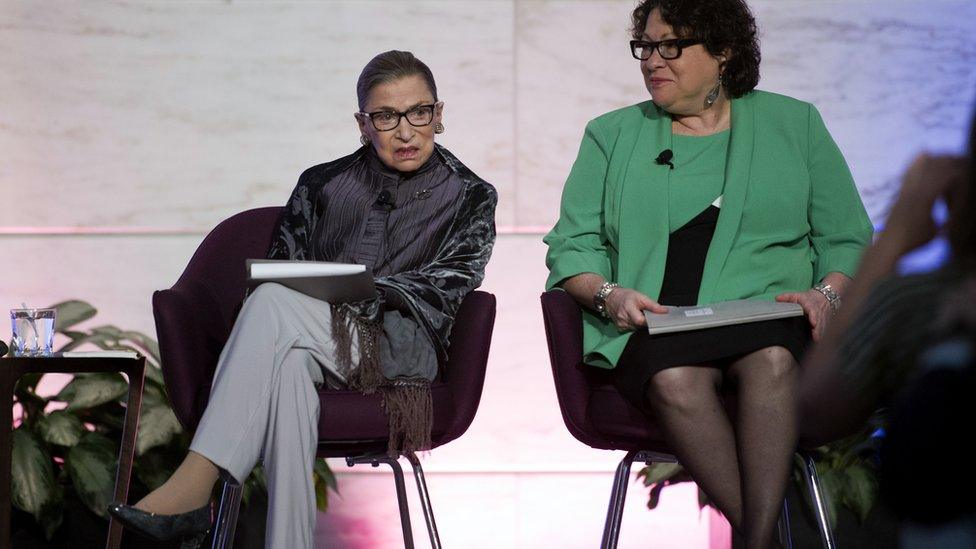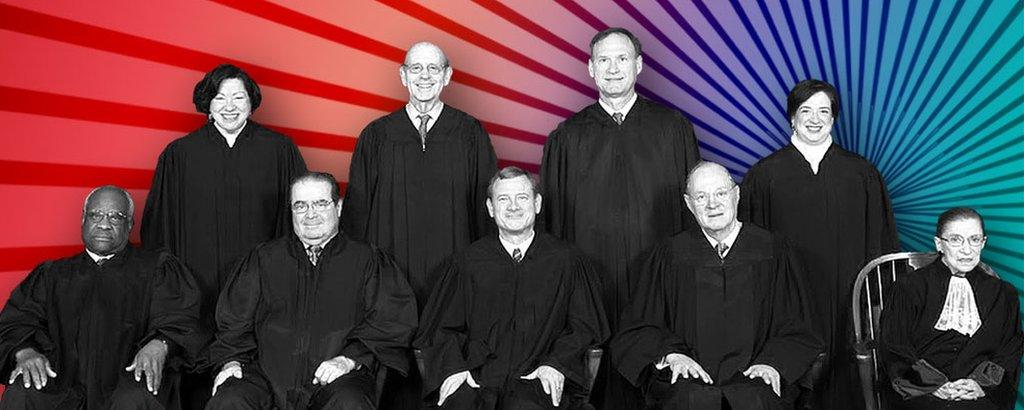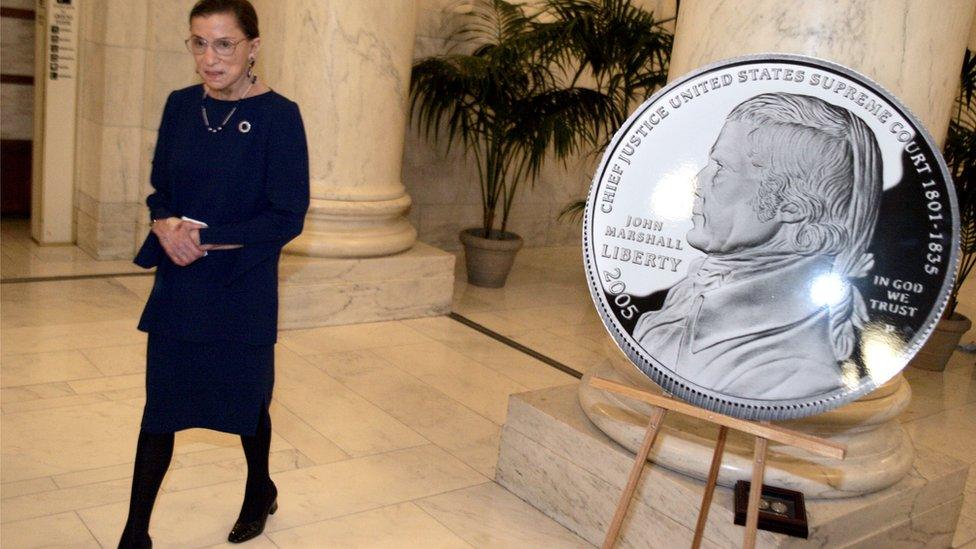The secrets of a Supreme Court diet
- Published

Supreme Court Justices Ruth Bader Ginsburg (left) and Sonia Sotomayor (right) said the justices never miss a birthday
Even Supreme Court justices, who preside over the highest court in the US, have to eat.
Despite often bitter partisan differences, the justices of the US Supreme Court have always dined together, as far back as the court's inception in the 18th Century.
Recently, Justices Ruth Bader Ginsburg and Sonia Sotomayor shared some culinary tales from the country's most powerful court with a packed audience at the National Museum of American History in Washington.
"It's good to remember that politics can end at the edge of a plate," said David Skorton, secretary of the Smithsonian, at the start of the evening.
Supreme dining of the past
In the early 1800s, the first Supreme Court justices all lived in a boarding house, sharing meals together - as well as a fondness for wine.
According to Justice Ginsburg, back then the justices tried to keep their imbibing in check by making a rule that it had to be raining to drink wine - though it was a rule they were willing to bend.
"Somewhere in our broad jurisdiction it must surely be raining," Chief Justice John Marshall is said to have declared, external on a sunny day, which freed up the justices to have a glass of wine with dinner every night.
When the boarding house style of living ended, rifts among the court began to show.
"[Marshall's] idea was that there should only be one opinion, there should be no dissents, and he would write it," said Justice Ginsburg. "When the boarding house broke down, so did the unanimity."
Wives of members of the court had elaborate social functions for the justices in the early era of the court. On Mondays, they were expected to have tea for everyone, serve scones and cakes, and provide entertainment.
The tradition held up until the Great Depression in the US in the 1920s when the tradition was deemed too expensive, said Clare Cushman, the director of publications at Supreme Court Historical Society.
Legal lunch break

In earlier days of the court, justices would have to slip behind the bench and eat quickly behind a partition while oral arguments were taking place, with the clattering of knives and forks hardly concealed.
Rumour has it that one day a justice popped open a bottle of champagne and the cork flew out over the bench.
Today, the justices are allotted one hour for lunch and have their own dining room.
Most days, the justices eat either food they brought from home, takeaway from the Senate cafeteria or have something delivered. Justice Sotomayor revealed she favours sushi, salads and Indian cuisine.
Birthdays are never missed - all the justices enjoy some wine and sing to the birthday boy or girl, Justice Ginsburg said.
Her late husband Martin Ginsburg, who she said was an excellent chef and baker, also prepared a cake for each justice's birthday.
As for mealtime conversation, no topic is off limits, but the justices try to "avoid controversy".
"We're very guarded about topics that might raise hostility in the room," said Justice Sotomayor. "The most common conversation is about a book one of the justices is reading. All of the justices are voracious readers.
"We tell funny stories about each other... it's that type of normal conversation people have that want to get to know each other as regular people, as not just justices."
Today's traditions

The Supreme Court justices used to live and dine together in a boarding house in Washington
The justices still enjoy their wine together, especially before the president's yearly State of the Union Address.
Justice Ginsburg recalled the year she famously fell asleep during President Barack Obama's 2015 address, thanks to the wine supplied by Justice Anthony Kennedy.
"I wasn't 100% sober," she said at the time.
Each justice brings their own food traditions to the other members of the court.
Justice Sotomayor recalled that a couple of times of year, former Justice Sandra Day O' Connor brought in a "very spicy" supply of beef jerky.
New York City pastries are a common treat from Justice Sotomayor, who said she "loves food" and that no meal should be wasted. On weekends, she brings in bagels with various cream cheeses, and tasks her clerks with finding new delivery places in Washington.
"One of my clerks' responsibilities during the year is to find a restaurant I haven't eaten at," she said. "It has expanded my knowledge of DC restaurants."
Her office is always stocked with candy, which she said brings people around more.
Another tradition is that the most junior justice on the court arranges the welcoming dinner for newly minted justices.
Justice Samuel Alito threw Justice Sotomayor a dinner complete with a guitar player performing Spanish music.
Martin Ginsburg would often coordinate with the spouses of the late Justice Antonin Scalia and Justice Anthony Kennedy to make a pre-State of the Union dinner for the court.
"Marty's fondness for the kitchen began shortly after I cooked my first meal [for him]," she said.
The two justices poked fun at some of the dining habits of their colleagues, like former Justice John Stevens, who was usually seen eating a plain cheese sandwich with the crusts cut off.
They also ridiculed former Justice David Souter for only eating plain yogurt and the occasional apple.
Dream dinner guests

Justice Ginsburg (left) would not pass up an opportunity to dine with former Chief Justice of the Supreme Court, John Marshall (right)
Both Justice Sotomayor and Justice Ginsburg said they would have dinner with Justice John Marshall - who was instrumental in the foundation of the American legal system, and died in 1835 - if they could.
Justice Sotomayor said she would also love to dine with former Justice Thurgood Marshall because she heard he never told a story twice.
However, there is one justice that Justice Ginsburg would avoid dining with, she said.
"I heard that if you went to dinner at the [Chief Justice Louis] Brandeis home, you would eat before and after."
- Published14 February 2015
